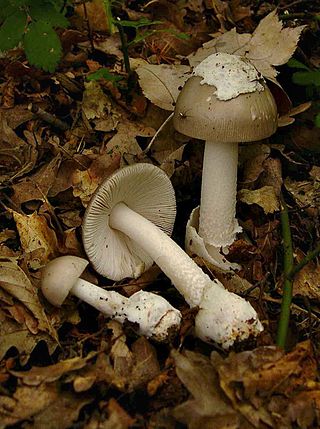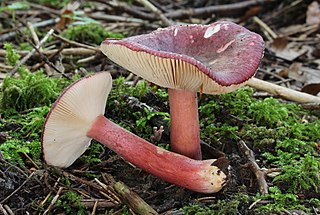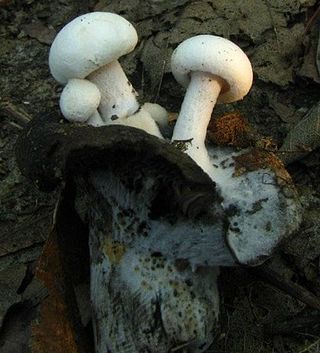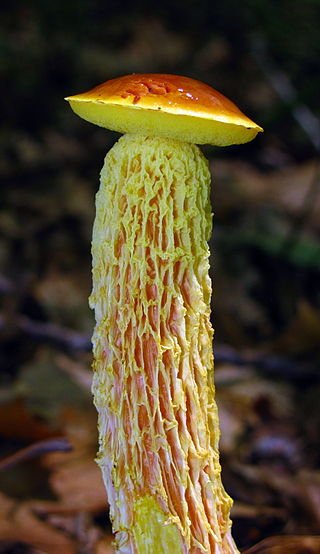
Amanita porphyria, also known as the grey veiled amanita or the porphyry amanita, is a fairly common, inedible mushroom of the genus Amanita found in Europe and North America.

Neolentinus ponderosus, commonly known as the giant sawgill, or ponderous lentinus, is a species of fungus in the family Gloeophyllaceae. Found in western North America, it was originally described in 1965 as a species of Lentinus by American mycologist Orson K. Miller.

Neolentinus lepideus is a basidiomycete mushroom of the genus Neolentinus, until recently also widely known as Lentinus lepideus. Common names for it include scaly sawgill, scaly lentinus and train wrecker.

Gymnopus dryophilus is a mushroom commonly found in temperate woodlands of Europe and North America. It is generally saprophytic, but occasionally also attacks living wood. It belongs to section Levipedes of the genus, being characterized by a smooth stem having no hairs at the base. Until recently it was most frequently known as Collybia dryophila.

Hydnellum aurantiacum is an inedible fungus, commonly known as the orange spine or orange hydnellum for its reddish orange or rusty red colored fruit bodies. Like other tooth fungi, it bears a layer of spines rather than gills on the underside of the cap. Due to substantial declines in sightings, this species is listed as critically endangered in the United Kingdom.

Ampulloclitocybe clavipes, commonly known as the club-foot or club-footed clitocybe, is a species of gilled mushroom from Europe and North America. The grey brown mushrooms have yellowish decurrent gills and a bulbous stalk, and are found in deciduous and conifer woodlands. Although considered edible, disulfiram-like reactions have been reported after consumption of alcohol after eating this mushroom.

Panus conchatus, commonly known as the lilac oysterling, smooth panus, or conch panus, is an inedible species of mushroom that occurs throughout the Northern Hemisphere. Its fruitbodies are characterized by a smooth, lilac- or tan-colored cap, and decurrent gills. The fungus is saprophytic and fruits on the decomposing wood of a wide variety of deciduous and coniferous trees. Despite being a gilled species, phylogenetic analysis has shown it is closely related to the pored species found in the family Polyporaceae.

Phylloporus rhodoxanthus, commonly known as the gilled bolete, is a species of fungus in the family Boletaceae. Like other species in the genus, it has a lamellate (gilled) hymenium and forms a mycorrhizal association with the roots of living trees, specifically beech and oak in North and Central America.

Amanita vaginata, commonly known as the grisette or the grisette amanita, is an edible mushroom in the fungus family Amanitaceae. The cap is gray or brownish, 5 to 10 centimetres in diameter, and has furrows around the edge that duplicate the gill pattern underneath. Unlike many other Amanita mushrooms, A. vaginata lacks a ring on the stem.

Cantharellus lateritius, commonly known as the smooth chanterelle, is a species of edible fungus in the mushroom family Cantharellaceae. The species has a complex taxonomic history, and has undergone several name changes since its first description by American mycologist Lewis David de Schweinitz in 1822. The fruit bodies of the fungus are brightly colored yellow to orange, and usually highly conspicuous against the soil in which they are found. At maturity, the mushroom resembles a filled funnel with the spore-bearing surface along the sloping outer sides. The texture of the fertile undersurface (hymenium) of the caps is a distinguishing characteristic of the species: unlike the well-known golden chanterelle, the hymenium of C. lateritius is much smoother.

Hygrophorus subalpinus, commonly known as the subalpine waxycap, is a species of white snowbank fungus in the family Hygrophoraceae. Found in the mountains of western North America, it is found growing on the ground under conifers, usually near snowbanks.

Russula queletii otherwise known as the gooseberry russula, is a common, inedible, Russula mushroom found growing in groups, predominantly in spruce forest. Eating this mushroom causes abdominal pains.

Asterophora lycoperdoides, commonly known as the star bearer, or powdery piggyback mushroom, is a species of fungus in the Lyophyllaceae family. It grows as a parasite on other mushrooms, mainly those in the genus Russula. Its gills are poorly formed or nearly absent. Asexual spores are produced on the mushrooms cap which enable the organism to clone itself easily. The spores are star-shaped, hence the name star bearer. It is regarded as nonpoisonous but inedible.

Hygrophorus purpurascens, commonly known as the purple-red waxy cap, is a species of agaric fungus in the family Hygrophoraceae. Its cap has a pink background color with streaks of purplish red overlaid, and mature gills have red spots.

Boletinellus merulioides, commonly known as the ash-tree bolete, is a species of bolete fungus in the family Boletinellaceae. Described as new to science in 1832, it is found in Asia and eastern North America, where it grows on the ground near ash trees.

Lentinellus montanus is a species of agaric fungus in the family Auriscalpiaceae. It is found at high elevations in the Pacific Northwest region of North America, where it fruits singly or in clumps on decaying conifer wood.

Phlebia incarnata is a species of polypore fungus in the family Meruliaceae. It is inedible.

Amanita pachycolea, commonly known as the western grisette or the Stuntz's great ringless amanita, is a species of agaric fungus in the family Amanitaceae.

Cortinarius alboviolaceus is a basidiomycete mushroom of the genus Cortinarius native to Europe and North America.

Aureoboletus betula is a species of mushroom producing fungus in the family Boletaceae. It is commonly known as the shaggy stalked bolete.




















